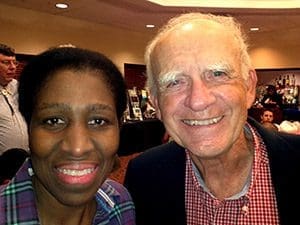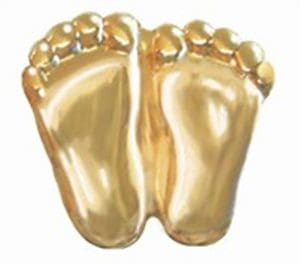Dr. Russell Sacco, an Oregon urologist reached his hand inside a formalin-laden bucket 44 years ago, and held the tiny, perfectly formed bodies of aborted babies. That single, horrifying experience changed his life forever.  Dr. Russell Sacco, a Kenosha native who earned his medical degree at the University of Wisconsin-Madison, held the tiny feet of an aborted baby in his fingers and snapped this photo in 1970 that has become a symbol of the pro-life movement worldwide. (Submitted photo courtesy Dr. Russell Sacco)
Dr. Russell Sacco, a Kenosha native who earned his medical degree at the University of Wisconsin-Madison, held the tiny feet of an aborted baby in his fingers and snapped this photo in 1970 that has become a symbol of the pro-life movement worldwide. (Submitted photo courtesy Dr. Russell Sacco)
It was 1970, and the now retired Dr. Sacco, a Kenosha native who earned his medical degree from the University of Wisconsin – Madison, was curious as to the allegations of abortionists who stated that an unborn baby was just a “blob of protoplasm.”
As a practicing Catholic, he believed human life began at conception; but was given no medical training about their development; so, he began studying human embryology to prove that those in the abortion industry were wrong.
“I had gone to the hospital while other doctors were doing surgeries and sat around with the pathologist and we got to talking about abortions,” he said. “After talking awhile, I remarked how bad it was and he said he wanted to show me something.”
Returning after a few moments, the pathologist handed the plastic bucket to the inquisitive doctor. Not wanting to destroy the tiny bodies, as he was supposed to do, the pro-life pathologist kept vats of aborted remains on a shelf in his office.
“I stuck my hand in and one by one and held about five or six of these little bodies and realized that not one of them were more than five months gestation,” Dr. Sacco said. “It was so awful and I felt that the only way I could explain to people about the reality of abortion was to photograph them, so I asked if I could take the bucket home and take pictures and prepare some slides and go out and give speeches.”
At home, he photographed each of the tiny bodies, but Dr. Sacco soon realized the public would never know the size of the babies without some comparison. So, he held the babies between his gloved fingers and took some pictures.”
“All of a sudden, I saw these tiny feet; these perfectly formed tiny feet, with little toes, little wrinkles and creases and I held them between my fingers and took the picture. I was crying because I felt so bad – it just really got to me,” he said. “I really didn’t think the photo would be anything, but God must have taken the picture because it was perfect, and I knew that this would be one powerful way to send a message to the world, as this unborn baby was only about 10 weeks along.” Dr. Russell Sacco, a Kenosha native whose photograph of the little feet of an aborted baby became the official symbol of the pro-life movement and was designed into the famous gold “tiny feet” pins that have been distributed worldwide, stands with Dr. Joan Sage, president of the Oregon Right to Life Board, at the organization’s auction on Sept. 28, 2013. (Submitted photo courtesy Oregon Right to Life)
Dr. Russell Sacco, a Kenosha native whose photograph of the little feet of an aborted baby became the official symbol of the pro-life movement and was designed into the famous gold “tiny feet” pins that have been distributed worldwide, stands with Dr. Joan Sage, president of the Oregon Right to Life Board, at the organization’s auction on Sept. 28, 2013. (Submitted photo courtesy Oregon Right to Life)
After developing photos of the aborted babies, Dr. Sacco presented them to schools, groups, commercial areas and spoke on television and radio to spread the pro-life message.
“I did this for a while because I especially wanted kids to know how developed these babies are at such a tiny age, so I would try to go someplace where they were at and some were nice and others would call me a bastard,” he said. “I went anyway, but later on, I kind of dropped off from doing it.”
When Roe v. Wade came before the Supreme Court, Dr. Sacco expected the court would rule against abortion because it was evident from his photographs that unborn babies are not “blobs of tissue,” but human beings.
“I was just so shocked that they went along with this,” he said. “Here I had the proof that these babies were not tissue, but real people. Since Roe v. Wade, more than 51 million babies have been murdered. It is horrifying.”
Dr. Sacco’s photos began making their way around the world and one day he received a call from Australia asking if he had a copyright on the tiny feet photo and if he required payment if it were to be used, and he said no, that everyone was free to use it to spread the word about abortion. The photos were copied and used among many pro-life groups.
In January 1974, as pro-lifers planned a march in Washington to commemorate the first anniversary of the Supreme Court decision, Virginia Evers showed the photo of the tiny feet to her husband Ellis, who decided the tiny feet picture would be the official symbol of the pro-life movement. Five years later, in Dublin, Ireland, the tiny feet symbol was named the international symbol of the pro-life movement. Evers and her husband, who operated Heritage House, a pro-life/family resource organization, designed the famous gold “tiny feet” pins that have been distributed all over the world.
 Virginia Evers and her husband, Ellis, who operated Heritage House, a pro-life/family resource organization, designed the famous gold “tiny feet” pins that have been distributed all over the world. (Submitted photo)When Dr. Sacco saw the pin, he was astounded and touched at the accuracy of the design.
Virginia Evers and her husband, Ellis, who operated Heritage House, a pro-life/family resource organization, designed the famous gold “tiny feet” pins that have been distributed all over the world. (Submitted photo)When Dr. Sacco saw the pin, he was astounded and touched at the accuracy of the design.
“They did it perfectly and designed it to match the size of the tiny feet I held, and was made of metal,” he said. “I was so surprised that this happened and very pleased. I am told that these pins and this picture have helped save lives and that makes me happy.”
According to Barbara Lyons, executive director of Wisconsin Right to Life, the “little feet” pins are a vital part of their pro-life education and outreach.
“They are an invaluable conversation piece,” she said. “Let me give you an example. My husband always wears his ‘little feet’ pin on his jacket lapel. Invariably, someone asks what they are for and he explains. He then offers to give them the feet he has on and replaces them with spares he keeps at home. Another person educated about the humanity of the unborn child who will spread the message to others. There are many people who do the same. I would guess we have distributed tens of thousands of these pins over the years and we always keep them in stock.”
Dr. Sacco, 78, lives in Lake Oswego, Ore., with his wife of 53 years, Elizabeth; he was one of the founders of Oregon Right to Life. He earned his medical degree from the University of Wisconsin – Madison and is also a retired attorney. The couple has four children and eight grandchildren, numerous nieces and nephews, including Mariann Kramer, the director of religious education at St. Elizabeth and St. Therese parishes in Kenosha.
“I have seen those ‘little feet’ pins since I was a very little girl and at the time, I didn’t know what abortion was, just the ‘little feet,” she said. “I remember asking Uncle Russ what they were and he said that the little gold feet were the feet of a baby. He then explained that they were the size of a 10-week old unborn baby.”
Kramer credits her uncle, who, growing up, served as an altar boy at Holy Rosary Parish, Kenosha, for fostering her pro-life beliefs.
“When I found out about my uncle and that he was behind the pins, it really affected me. He is a cool guy, a guy who likes to play magic tricks, is a surgeon and a lawyer. He is intelligent and I have always felt connected to him intellectually and we are of like minds,” she said. “I always accepted that this was part of him and it made total sense that he would have come up with this.”
While she doesn’t speak about her famous uncle a lot, she occasionally tells the story, especially to her students.
“I am so proud of my uncle for lots of reasons,” said Kramer. “He put the feet to abortion and he wrote an amazing letter to Oregon Right to Life that was worded so perfectly on what happened and why he took the photograph.”
